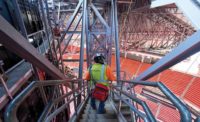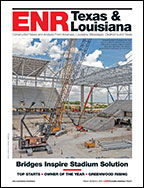As Challenges Go, Iraq Stadium Geometry Is Iceberg's Tip












Every couple of months, when non-Iraqi representatives of the design team, mostly from the U.S., visit the site of the $100-million Al-Menaa Sports Complex in a suburb of Basra, they move in and out of the war-torn nation with as much secrecy as possible. All travel plans and meeting locations are kept confidential. They alert only one construction executive to the trip. While there, they have armed guards escorting them at all times. Instead of a construction fence, a precast-concrete security wall surrounds the site.
"We even have to be careful about how we send e-mails about travel to the site," says one of the members of the project's lead architect, 360 Architecture, Kansas City, Mo. "Our counterparts on the construction side have had their lives threatened," he adds, declining to be named in quotations for this article for reasons of safety and security.
The Al-Menaa complex is the second of three 360 Architecture sports venues in Iraq. The first project in Iraq is the $700-million, two-stadium Basra Sports City, set for completion late this year. The third is the 30,000-seat Al-Najaf stadium in Al-Najaf, which is trailing Al-Menaa.
The 65,000-seat Basra stadium project was prompted by the selection of Iraq to host the 2013 Gulf Cup of Nations soccer tournament. The Basra, Al-Menaa and Al Najaf projects are part of a national program, led by the Iraq Ministry of Youth and Sport, Baghdad, to build a network of athletic facilities. The goal is to build 30,000-seat stadiums in each of Iraq's 18 provinces. Currently, there is an estimated $1.5 billion worth of sports construction in Iraq.
For all of 360 Architecture's work in Iraq, "our staff's personal security is paramount," says the architect. All the precautions have paid off, he says. "We have had no safety or security issues with our staff to date," he notes.
The centerpiece of the Al-Menaa project is a 30,000-seat stadium with a structural-concrete seating bowl covered by a 30,175-sq-meter, fabric-covered cable-stayed steel canopy structure. The geometry is challenging. 360 Architecture is part of a design-build team for the complex, led by Anwar Soura for General Contracting Co., Amman, Jordan. Anwar Soura is part of the Abdullah A. Al Jiburi Contracting Co.
As with the Basra Sports City project, the ministry selected the 360 Architecture team through an international design competition. The team consists of Cairo-based associate architect RMC; New York City-based structural engineer Thornton Tomasetti (TT); and New York City-based mechanical-electrical-plumbing-fire protection engineer, WSP Flack+Kurtz.
Work on the stadium, which is about 40% complete, began last July. The design is currently 80% complete.
Basra—located along the Shatt Al-Arab River, 340 miles south of Baghdad near the Kuwait border—is Iraq's second-largest city and its main port. The stadium's canopy, open in the center over the field, relies on 48 steel masts and rigging that reflect the port's many tower cranes and ships. The membrane's undulating surface of ridges and valleys reflects waves on the water, says 360 Architecture.
For the design team, security and safety aren't the only issues that distinguish the project. Not much has been built in Iraq in about 40 years. The Ministry of Youth and Sport itself is only about 10 years old. Government tendering is also a "growing process, which is pretty fragile," says the architect.
For example, the stadium is designed to international codes and standards. When the project began, Iraq had no building code. The design team submitted a list of international codes that would be used and got approval for their application on the project.










